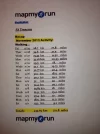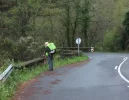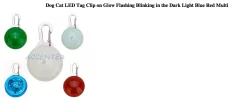I recently completed my second Camino France;s 27 April - 30 May, 2014. During the 34 days on the Way, I experienced 20 days of rain, snow, or low light / poor visibility. When I reached O'Cebreiro, in mid-May, there was a total white-out in effect from a snow squall. It only lasted an hour or so, but you could not see 50 meters in front of you. Based on this additional experience, and in the name of fairness and journalistic accuracy and personal integrity, I need to modify some of my prior comments regarding being safe whilst road walking.

My earlier suggestions revolved around buying and carrying additional small items to increase my "visibility profile" while road-walking. This year, I refined that solution. I believe my revised idea saves weight and complexity.
Instead of carrying separate hi-vis vests, leggings, bands straps, blinky lights and the like (all of which add incremental weight), I am now of the opinion that there is a far simpler and lighter weight solution. It just looks a bit strange, and it might strike some as slightly wacky. But this is the Camino, NOT a fashion catwalk...

My observation - I was paying far closer attention this year - is that simply wearing colors NOT found in nature on a dimly lit, cloudy, rainy, snowy day significantly increases your visibility to a driver.
The greater the contrast against a prevalent green, brown, tan, grey or white (snow) background, the better your chances of being seen. My modified solution includes buying outer wear, jackets, fleece, ponchos, head gear, gloves and even rucksacks, in something like the lemon-yellow, hi-visibility color (or similarly bright) to what road and construction workers wear when they work alongside the road with traffic flashing by.
Simply put, wearing a rain poncho that is black, rust, dark or olive green, brown, etc., is not as effective at alerting a driver to your presence as is lemon-yellow, international orange, or any other bright contrasting color that the driver would not normally see. The contrast attracts attention. You WANT attention when you are walking against oncoming traffic.

This year, I wore a light, bright blue siliconized nylon poncho by Sea to Summit. Last year, I wore a deep red Ferrino walking raincoat. I know I was more visible against the green scenery prevalent along most of the Camino in the light blue poncho than last year's deep red.
I also purchased a lemon-green-yellow Outdoors Research "OR" ball cap I came across at Ponferrada. At first, I just thought the color was "cool." But as I walked, I realized this made my head a lot more visible than tan, black or grey might have. I also had a tan sun hat that I used - well - on bright sunny days...

Blinky lights and LEDs still have a place in the overall scheme. But looking like an alien from another planet as you walk is not the solution.

My hiking poles still have three rings of 33 mm (1 inch) wide, 3M reflective tape above each section collar. Waving these reflective poles perpendicular to an oncoming driver always gets their attention, especially if they have their headlights on. It is all in the wrist. I also carried one set of red and white bicycle blinky lights that could mount on my hiking sticks if desired.
However, it occurred to me after looking at my reflection in shop windows as I was walking, that the huge light blue blob in the poncho (the poncho also covered the rucksack) with the day-glo hat was just as visible to an oncoming motorist as my previously described hi-tech scarecrow, mentioned and discussed above, and with no incremental weight penalty.
BTW, I never used the pair of blinky lights. By the time I needed them, I had sufficiently adopted the high-contrast color scheme I am now recommending. The LED lights became dead weight.
For the record, after several crappy, cloudy, rainy days of walking, I posted about a kilo of separate hi-vis gear I had prepared, and as discussed above, to Ivar at Santiago to hold for me. We continue to learn as we progress. It is part of life...
In fact, last year, I sent Ivar three boxes. This year I sent him four. I guess some people are harder to teach than others.

In my defense, much of this over-weight gear included items I brought specifically to test for review here. Some was donated along the way. Other items were mailed to Santiago. I WILL eventually arrive at my perfect Camino kit. To this end I am committed. besides, it gives me something to do in the off-season.

As always, I hope this insight helps someone.
























